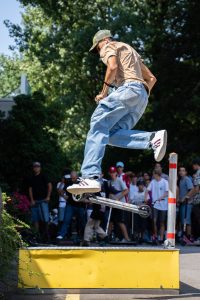We’ve all seen them in parks, on the streets, or perhaps even in our own backyards – teenagers zipping around effortlessly on their scooters. But have you ever stopped to wonder what those impressive stunts and maneuvers they’re pulling off are called? We’re here to help demystify some of these popular stunts that have captured the imagination of teens worldwide. From the agile tailwhip to the dizzying 360, we’ll break down each stunt, so next time you see a teen perform it, you’ll be able to appreciate not just their skill but also their dedication.
Get ready for an exciting journey into the world of stunts! Whether you’re a parent trying to understand your child’s new hobby or simply curious about this trending sport, let’s dive right in!

This content is not for gas-powered scooters. Scooters are an incredibly fun and safe way for teens to enjoy the outdoors. Through stunts, teens can learn about balance, coordination, and even the physics behind the stunts.
Here we’ll cover some of the most popular stunts, including the Tailwhip, Bar Spin, and 360. We hope that this article will serve as a helpful guide to understanding the stunts that teens are doing today.
Key Takeaways

Scooters are a great way for teenagers to express themselves and have fun. We’ve explored some of the most popular tricks among teens: the Tailwhip, Barspin, Bunny Hop, 360, Manual, and the classic Backflip. These tricks are sure to impress and add a thrilling twist to scootering! When it comes to safety, make sure to check the manufacturer’s instructions.
The Tailwhip
When it comes to iconic tricks, the Tailwhip often tops the list. For many riders, it’s the gateway trick that paves the way to more advanced maneuvers.
In a Tailwhip, the rider pushes off the ground to get airborne. As they lift, they use their feet to kick the deck, causing it to spin horizontally around the handlebars. The deck whirls in a full 360-degree motion around the stem. The true magic is in catching the deck mid-air with one’s feet and then gracefully landing back on it.
Perfecting the Tailwhip involves understanding the scooter’s weight, finding the right balance, and practicing the timing of the kick and catch. Getting the rhythm right ensures that the deck spins just enough to come back to the rider’s feet before landing.
Over time, riders often add variations to the Tailwhip, such as the double or even triple Tailwhip, where the deck spins two or three times respectively before being caught.
The Barspin
The Barspin is another fundamental trick that’s all about control and precision. It demands a strong core and good hand-eye coordination. In the Barspin, the rider jumps, letting go of the handlebars, which are often black for aesthetic appeal, and quickly spins them 360 degrees before catching them again, all while airborne. The challenge is maintaining control during the spin and ensuring a smooth landing.
One crucial aspect of the Barspin is the rider’s grip on the scooter handlebar. Before attempting this stunt, many riders loosen their grip slightly to allow the handlebars to spin freely. However, being too loose can be risky, as it could lead to a lack of control. It’s a delicate balance that requires practice to perfect.
Advanced riders often combine the Barspin with other stunts on their scooters, like tailwhips or jumps, to create a combination move. For instance, a Barspin to Tailwhip involves spinning the handlebars and then immediately whipping the deck around before landing.
Both the Tailwhip and Barspin are foundational stunts that every aspiring rider aims to master. They serve as stepping stones to more intricate moves and combinations, showcasing a rider’s skill, balance, and creativity.
Advanced Barspin
Ready to amp up your game and show off some advanced barspin moves? Whether you’re a seasoned pro or just starting out, incorporating barspins into combos can be a challenging yet exciting way to show off your stunts. From the basic bunny hop to more advanced barspin stunts like the tailwhip and the double barspin, you’ll find plenty of options to take your game to the next level. Remember, continuous practice is the key to mastering any stunt.
- Basic Barspin: The essence of this stunt involves spinning the handlebars 360 degrees while mid-air. Proper hand placement and a tight grip are essential.
- Tailwhip to Barspin: A blend of the classic tailwhip and barspin. Initiate a tailwhip, and as the deck comes around, grip the handle and execute a barspin before landing.
- Double Barspin: Twice the spin in a single jump! It requires faster hand movement and more airtime.
The Bunny Hop
The Bunny Hop is a quintessential maneuver frequently showcased by teenagers. To perform it effectively, it’s essential to understand bunny hop mechanics and make necessary adjustments. It’s not just about showing off but also about enhancing one’s skill set and contributing to the vibrant community.
A fundamental move, the Bunny Hop serves as a gateway to many advanced stunts:
- Basic Bunny Hop: Compress your body, pull the handlebars towards your chest, and use your foot’s momentum to lift the scooter off the ground.
- Bunny Hop 180: Add a twist! As you hop, turn your body and scooter 180 degrees before landing.
- Bunny Hop Barspin: Combine the basic hop with a barspin for added flair.
The 360
Step up the thrill with the 360! First, equip yourself with protective gear and familiarize yourself with the basics before taking on this trick. As you get comfortable, explore different 360 variations, adding a touch of uniqueness to each move. Encourage others with your feats, but always prioritize safety.
Once you’ve got the basics down, challenge yourself to try different variations of the 360 and add your own unique flair! With the right patience and dedication, you can not only proudly show off your cool stunt in your community but also inspire others to do the same.
A full-circle aerial spin:
- Standard 360: Start with a good run-up, jump, and use your shoulders and hips to turn the scooter a full 360 degrees in the air before landing.
- 360 Tailwhip: While spinning, add a tailwhip to the move. This requires impeccable timing and coordination.
When it comes to safety, all vehicles should be equipped with essential features such as brakes, lights, and reflectors.
The Manual
Moving on from the thrilling 360, let’s explore another favorite among teenage enthusiasts – The Manual. This stunt tests your manual balance techniques to the limit and is only possible on non-gas-powered scooters. It involves riding with the front wheel in the air and maintaining balance.
There are several manual variations you can master with practice and patience.
Balancing on the rear wheel:
- Standard Manual: Push the handlebars forward slightly and lean back to lift the front wheel. Use your foot’s positioning to maintain balance.
- Manual to Barspin: While maintaining the manual, throw in a barspin. Ensure you’ve got a good balance before attempting the spin.
The Backflip
You’re about to tackle one of the most daring feats on a manual scooter – the backflip!
Remember, it’s all about practice and patience. Backflip safety measures, such as helmets and pads, are non-negotiables. With dedication and commitment, you’ll soon be able to astonish everyone with your new skill!
The backflip is categorized under extreme sports and requires agility and balance. It’s crucial to start slow and practice with the right materials, such as sturdy scooters, protective gear, and a soft surface.
A high-risk, high-reward maneuver:
- Standard Backflip: Requires a steep ramp or an incline. Build speed, pop off the lip of the ramp, lean back, and tuck your knees. Spot your landing and extend your legs as you come around.
- Backflip Tailwhip: As you initiate the backflip, add a tailwhip. Coordination and ample airtime are crucial.
Mastering the backflip is no easy task and requires commitment and practice. Keep at it, and you’ll be sure to be the talk of the town!
Conclusion

Scooters come in all shapes and sizes, but the ones that are most popular among teenagers are the ones with stunts! From the Tailwhip to the Barspin and the Bunny Hop, these stunts are a hit with teenagers everywhere. Don’t forget the 360, the Manual, and the classic Backflip! Not only do the showcase skill, but they also add a fun and exciting twist to scootering.
So let’s get out there and practice until we master them!
Frequently Asked Questions (FAQs)
How To Do Stunts Easily?
When planning to purchase a scooter for stunts, particularly a stunt scooter, it’s essential to look at the picture and descriptions of the product to ensure its suitability for a pro stunt. For beginners, having enough space is vital for practice. The bunny hop, requiring a jump and lifting the scooter, is an excellent start, emphasizing size and height in your jumps. As riders gain more live experience, the selection of stunts they can execute grows. “Tailwhips” and “bar spins” are perfect examples of this progression. Always have high quality protective gear on, and before making any move, ensure your cart includes all necessary safety equipment for teens and adults. If ever in doubt, it’s a good idea to close out distractions and focus on one stunt at a time. After all, with a lot of practice, mastery comes easier, particularly for scooters for teens.
What Stunts Can You Do?
Riders can perform a range of stunts, including the “bunny hop,” “tailwhip,” “bar spin,” “fakie,” and “360 spins.” As skills develop, riders can explore more advanced stunts like “flairs” and “backflips.” Whether for kids or adults, it’s crucial to always practice new stunts in controlled settings, like skate parks which often have dedicated areas for pro scooters.
What Is The Difference Between Stunt Scooter And Normal Scooters?
A stunt scooter has a more durable and compact chassis, solid (non-adjustable) handlebars, and frequently a smaller turning radius. It is made primarily for stunts and leaps, often being part of the pro scooter line. In contrast, a normal scooter is designed primarily for transportation, ideal for kids and adults alike. It may have adjustable handlebars and a more comfortable deck and is generally not built to withstand the stresses of pro stunt work.
What Makes A Stunt Scooter?
Often known as pro scooters, stunt scooters are made for the primary purpose of executing stunts and tricks, especially popular tricks for teenagers. A significant feature is its lightweight design, which allows for easier maneuverability in the air, making them ideal scooters for teens. The handlebar is usually fixed in height to provide maximum durability and ensure there aren’t any weak points. Its brake is robust, ensuring quick stops after stunts. While they are especially suitable for teens and adults, many adults also engage in scootering, appreciating the durable design tailored for stunts. An essential thing to note is the swift loading time of a modal window when accessing online tutorials, where selected captions can guide users in understanding tricks better.
Why Are Scooters Easy To Ride?
They are easy to ride due to their intuitive design. The handlebars provide stability, the deck offers a firm footing, and the low center of gravity simplifies balancing. The push-and-glide motion is also straightforward, allowing even beginners to pick up the basics quickly.
Are Scooters Easy To Learn?
Scooters are easy to ride due to their intuitive design, often making them the first choice as scooters for kids. The handlebars provide stability, the deck offers a firm footing, and the low center of gravity simplifies balancing. The push-and-glide motion is also straightforward, allowing even beginners to pick up the basics quickly, a feature also beneficial for complete scooter models.
Are Stunt Scooters Adjustable In Height?
Also known as trick scooters, they are specifically designed for performing tricks and stunts. Typically, they come with a fixed height to ensure maximum stability and strength, especially when landing tricks. The non-adjustable design prevents any weak points or potential breakage points that can arise from adjustable components. If you’re looking for a scooter that can be adjusted to fit different heights, it’s better to consider other types, as they prioritize durability and performance over adjustability.
How To Do Skills On A Scooter?
Building skills on a scooter involves consistent practice, starting with basic moves before progressing to complex stunts. A good starting point is mastering balance and control with moves like the “manual.” Over time, riders can incorporate spins, jumps, and grinds. Practicing in safe environments and using protective gear is essential.
How Should You Stand On A Scooter?
When standing on a scooter, position one foot towards the front of the deck, with the other at the back or resting on the ground for pushing. Keep your knees slightly bent for better control and balance. Your dominant foot can either be in front (called the “regular” stance) or behind (called the “goofy” stance), depending on what feels most comfortable.
How Much Weight Can A Trick Scooter Hold?
The weight limit of a stunt scooter varies based on its design and build quality. Most standard stunt scooters can support riders weighing up to 220 pounds (100 kg). However, checking the manufacturer’s specifications for each specific model is vital to ensure safety and optimal performance.
DISCLAIMER (IMPORTANT): This information (including all text, images, audio, or other formats on FamilyHype.com) is not intended to be a substitute for informed professional advice, diagnosis, endorsement or treatment. You should not take any action or avoid taking action without consulting a qualified professional. Always seek the advice of your physician or other qualified health provider with any questions about medical conditions. Do not disregard professional medical advice or delay seeking advice or treatment because of something you have read here a FamilyHype.com.